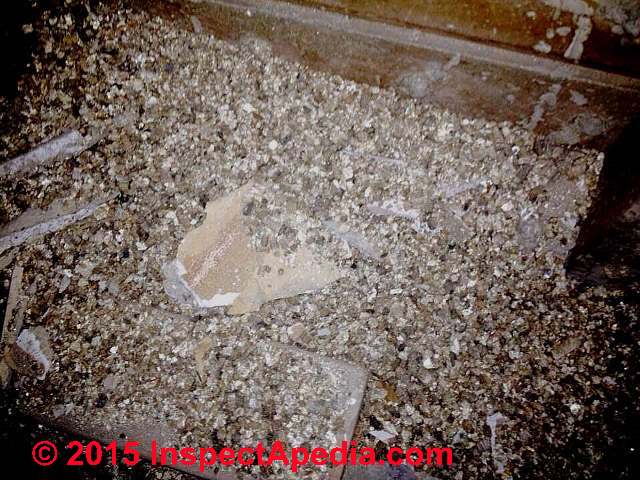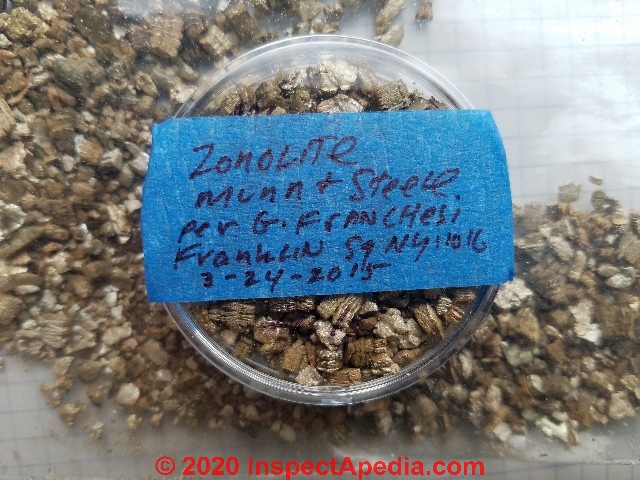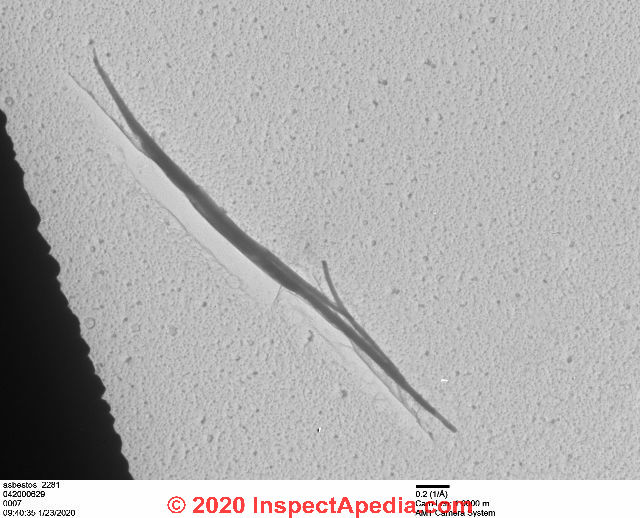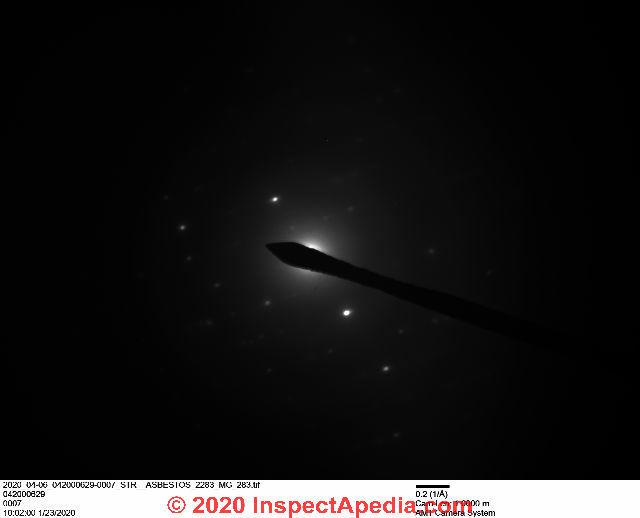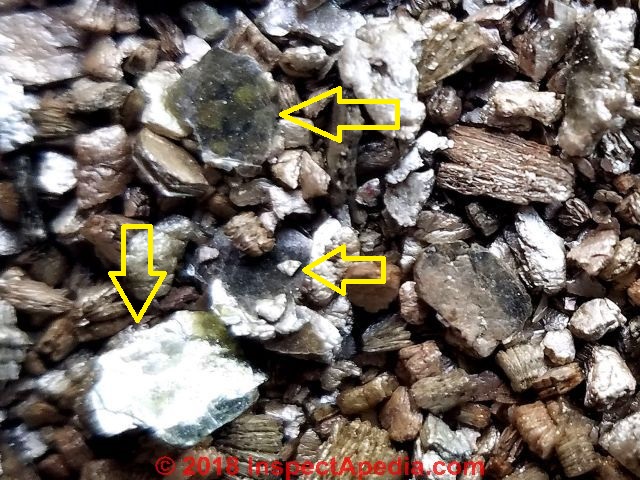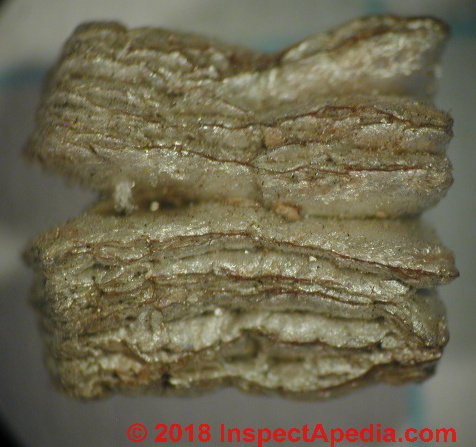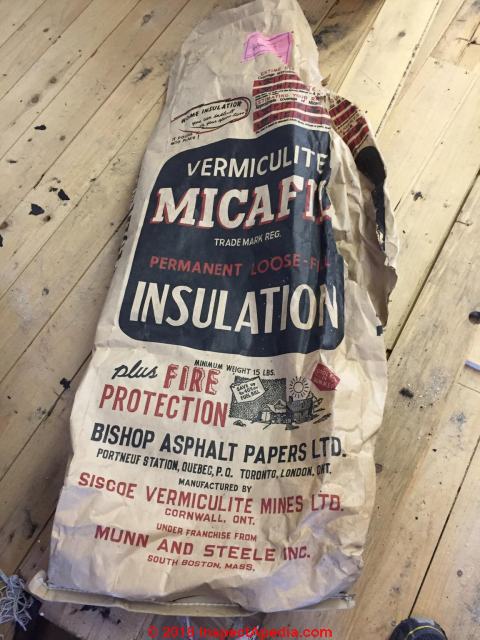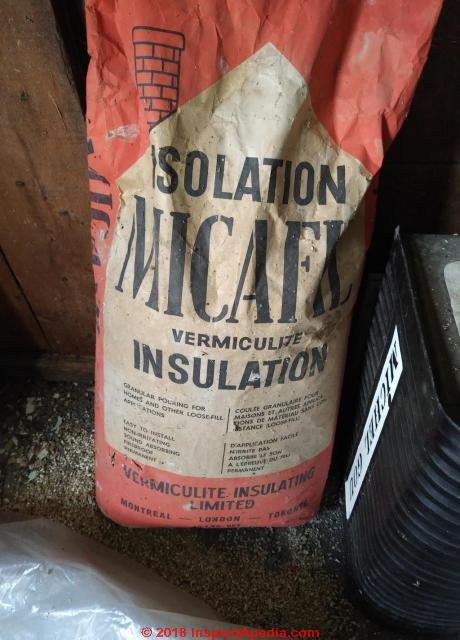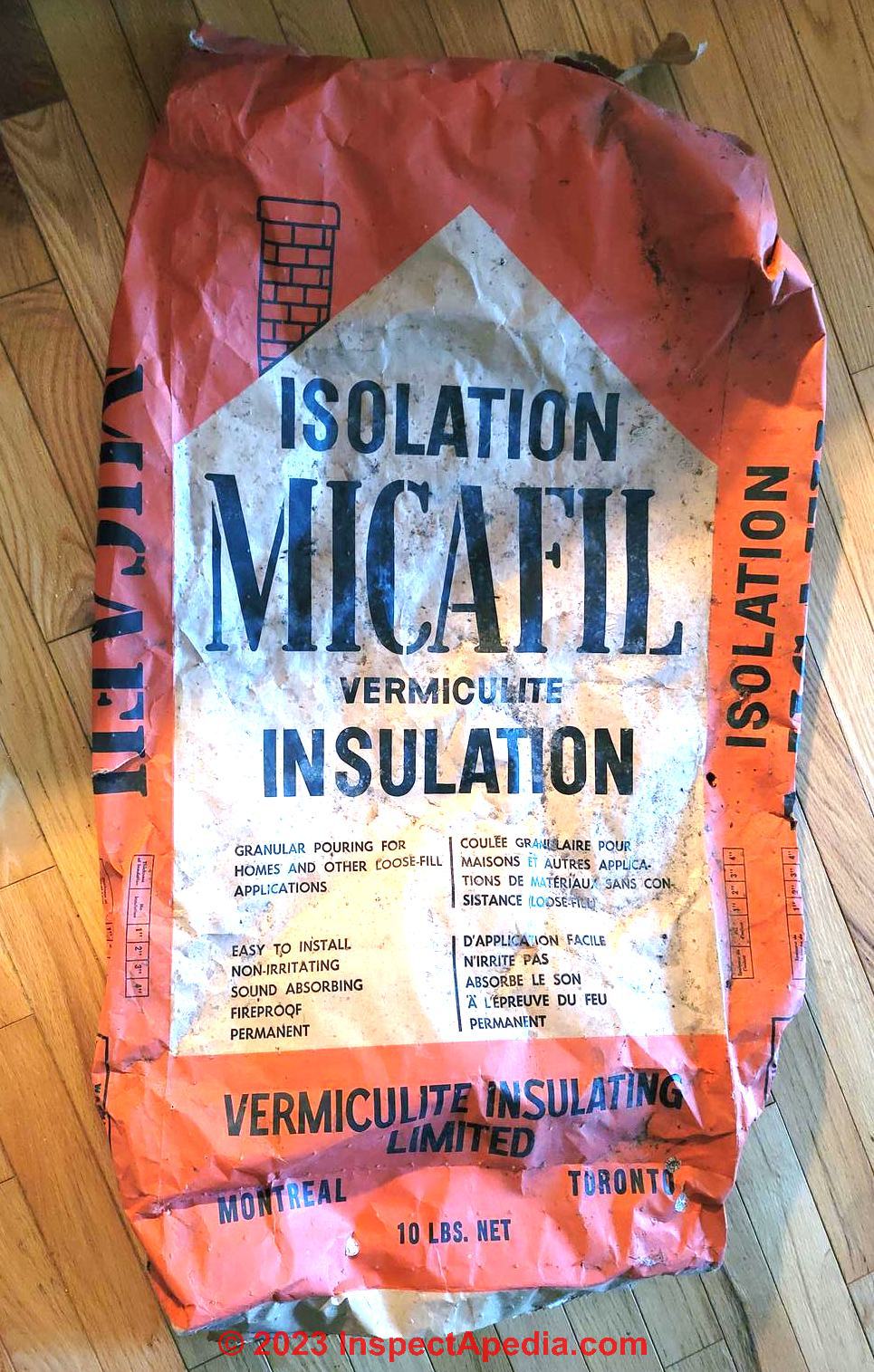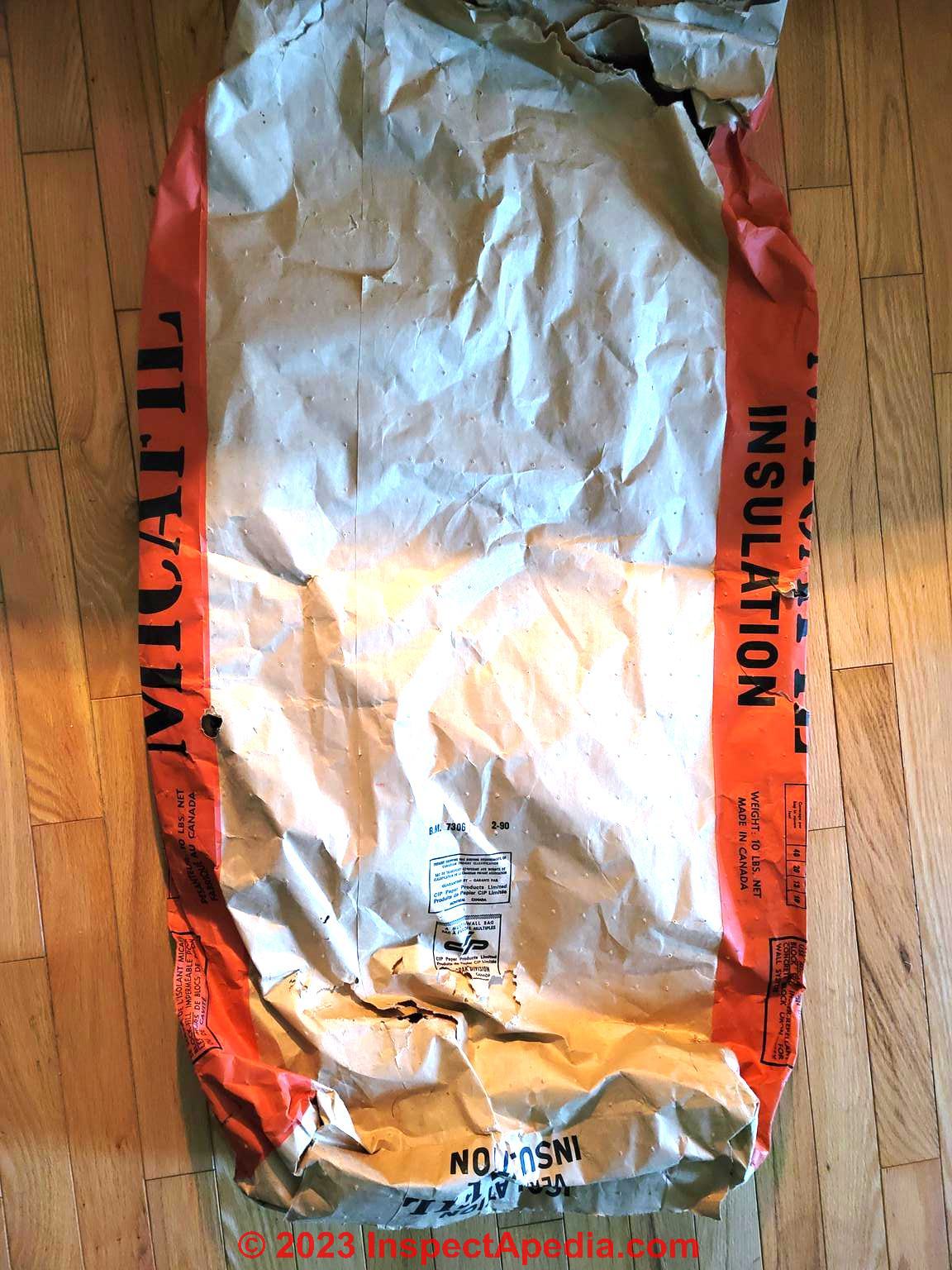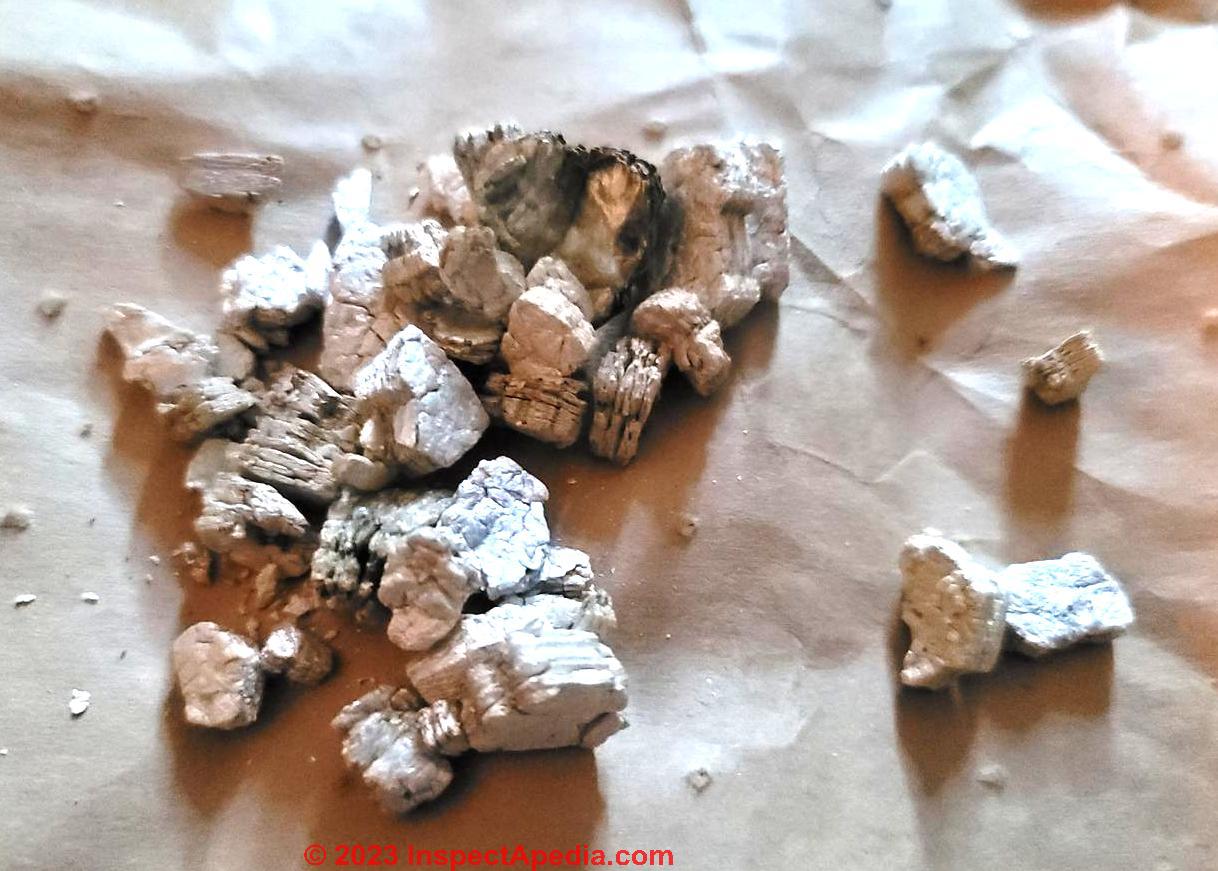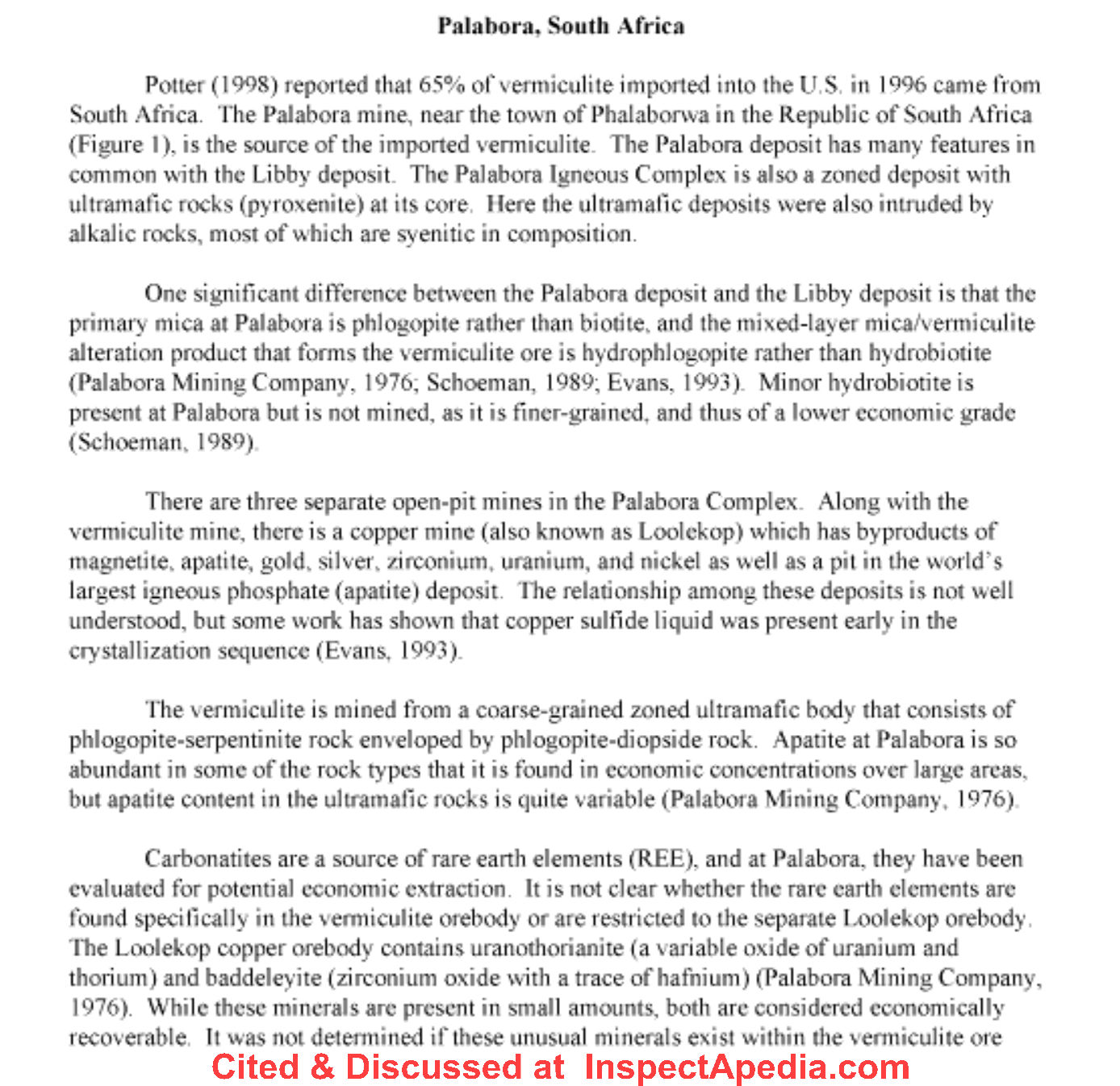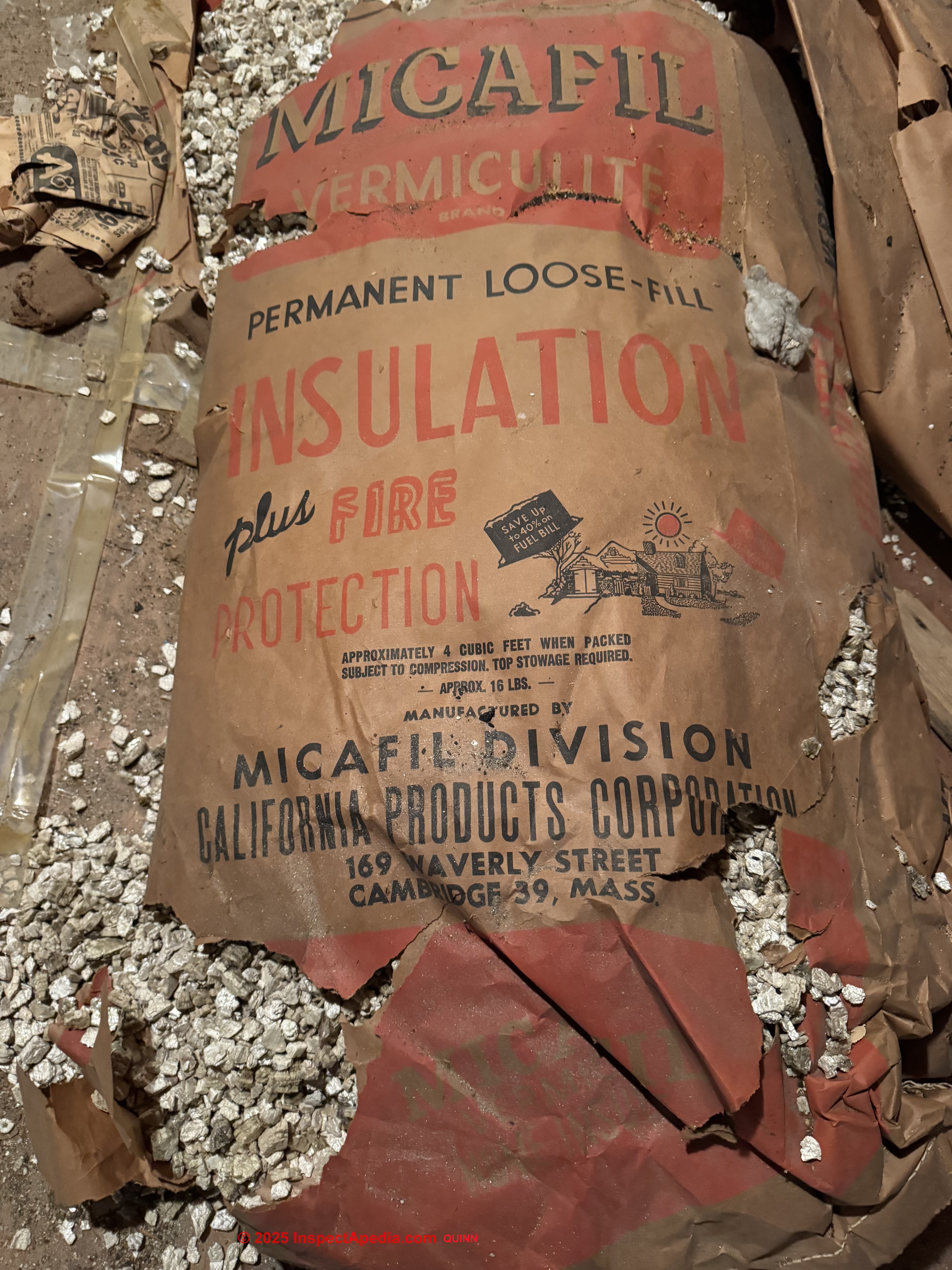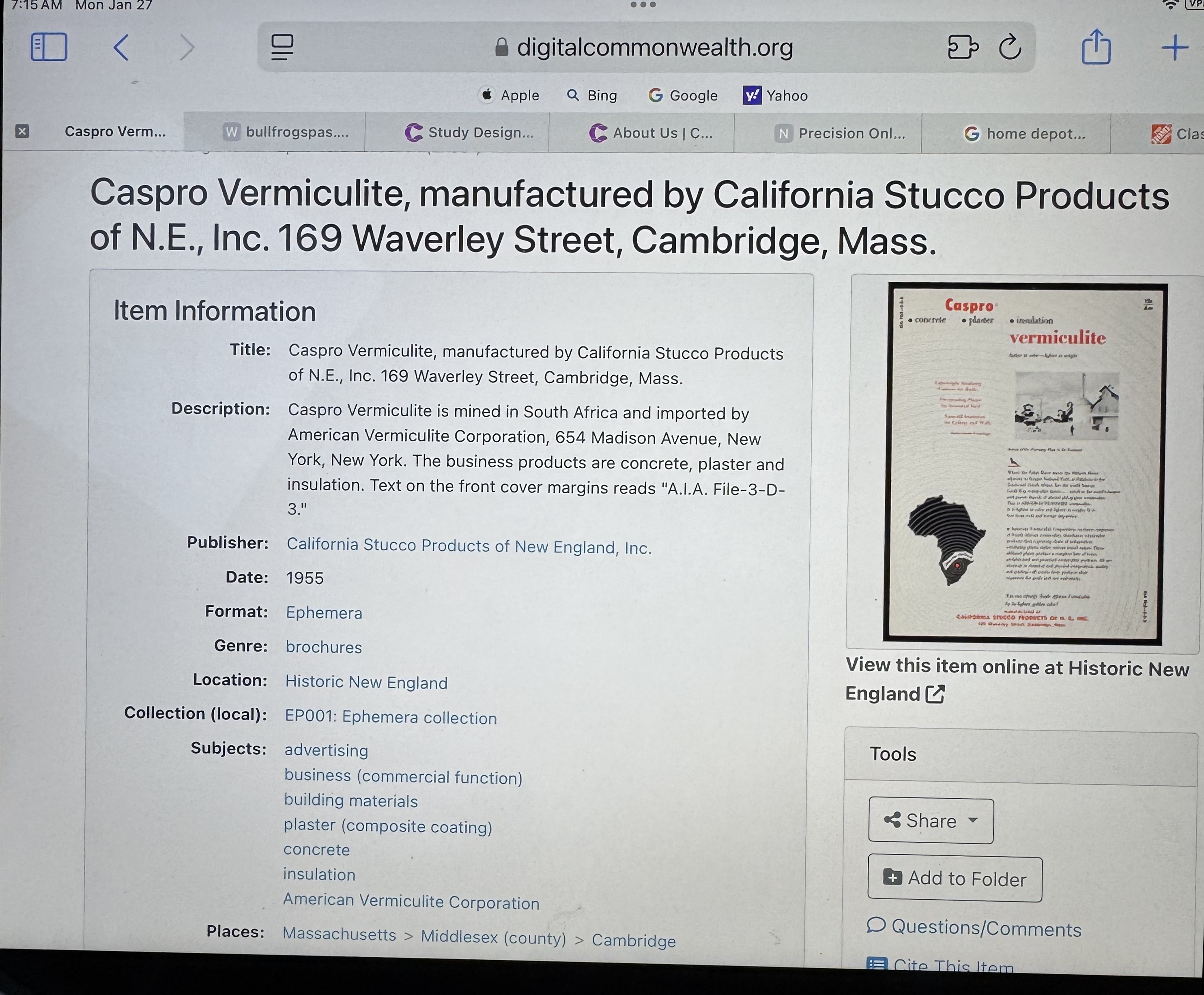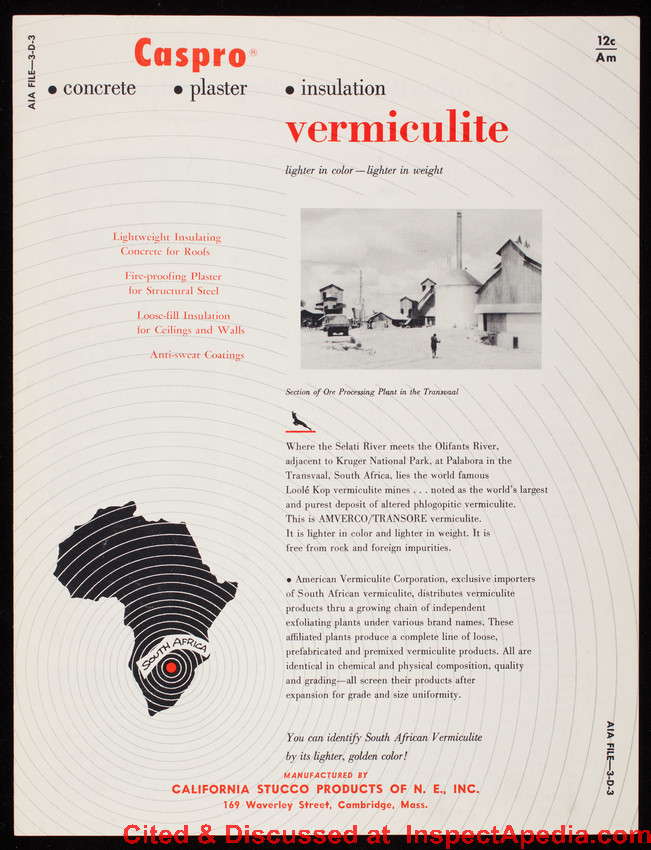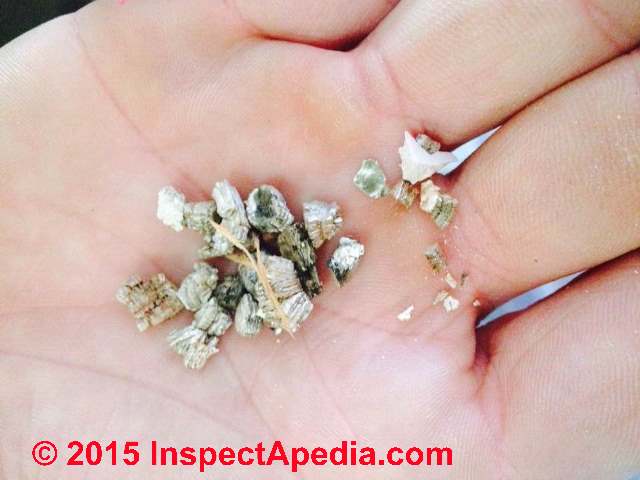 Munn & Steel & Mica-Fil Vermiculite Building Insulation
Munn & Steel & Mica-Fil Vermiculite Building Insulation
MicaFil Vermiculite identification photos, hazards, history, advice
- POST a QUESTION or COMMENT about vermiculite insulation & asbestos content of vermiculite
Vermiculite insulation produced or sold by Munn & Steele and other Mica-Fil Brands may or may not be likely to contain asbestos depending on where it was mined.
How are Mica-Fil or Munn & Steele vermiculite products identified, & what should be done about potential vermiculite-asbestos hazards ascribed to this vermiculite insulation?
This article series explains how to recognize vermiculite building insulation that may contain asbestos fibers. This article permits visual identification of vermiculite insulation; we include our own as well as US EPA photographs of various forms of vermiculite insulation to assist in recognizing vermiculite in buildings.
We provide photographs and descriptive text of asbestos insulation and other asbestos-containing products to permit identification of definite, probable, or possible asbestos materials in buildings.
InspectAPedia tolerates no conflicts of interest. We have no relationship with advertisers, products, or services discussed at this website.
- Daniel Friedman, Publisher/Editor/Author - See WHO ARE WE?
Mica-Fil & MicaFil Vermiculite Insulation Asbestos, Producers, Mines
Bottom line: No serious health risks have been found resulting from the exposure to vermiculite alone nor are any anticipated in view of its long-term chemical durability, even with respect to fibers of vermiculite.
Vermiculite ores may contain a variety of other minerals including asbestos, which, if present in significant quantities, could pose a health risk to producers and end users. (Addison 1995)
Does Munn & Steele vermiculite insulation contain asbestos? What about Mica-Fill vermiculite insulation under other brands or from other locations in the U.S. and Canada?
What about asbestos MicaFil vermiculite mined in South Africa?
Article Contents
- CANADIAN MICAFIL VERMICULITE ASBESTOS - not detected
- CALIFORNIA STUCCO PRODUCTS VERMICULITE ASBESTOS - Caspro vermiculite - from South Africa
- SOUTH AFRICAN MINED VERMICULITE ASBESTOS - not detected; in 1996 65% of vermiculite imported into the U.S. came from South Africa
- LABELING & PACKAGING EXAMPLES of VERMICULITE INSULATION - Munn & Steele vs the Ontario Siscoe Mine
- MUNN & STEELE MICA-FIL from the SISCOE VERMICULITE MINES - asbestos detected in some samples
- MUNN & STEELE VERMICULITE ASBESTOS TEST RESULTS - Libby Montana Vermiculite Mine: Libby vermiculite ... contains amphibole minerals including tremolite, actinolite, richterite, and winchite. (Price 2007)
- STEPS TO MINIMIZE ASBESTOS HAZARD RISK from VERMICULITE INSULATION
- MICA FIL INSULATION RESEARCH & INFORMATION SOURCES
...
Munn & Steele Vermiculite Insulation, Siscoe Vermiculite Mines, & Mica-Fill Vermiculite Insulating Products
Munn & Steele Vermiculite Insulation Identification
These photos of Munn & Steel vermiculite were found in a 1945 row house in Queens, New York. Our reader found the words Munn& Steele and Zonolite on fragments of paper backing along with a Newark New Jersey address for the company. Our reader commented
The paper is brown and the Munn lettering is in black with red, while the Zonolite is in a light blue and the word mineral is in black lettering. The paper looks old - Like from the 40's or 50's. The substance is flaky and shiny.
Zonolite (a brand of vermiculite insulation) coming from the Libby mine contained asbestos while vermiculite from other sources often contains either very slight traces or no traces at all of asbestos.
History of Munn & Steele's Vermiculite & the Siscoe Vermiculite Mines
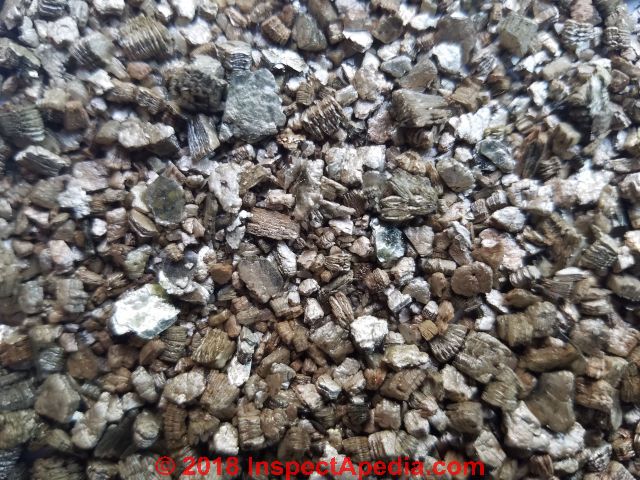 John R. Munn, from an old Newark New Jersey family, was chairman of Munn & Steele Inc., makers of building insulation material, including vermiculite insulation.
John R. Munn, from an old Newark New Jersey family, was chairman of Munn & Steele Inc., makers of building insulation material, including vermiculite insulation.
Photo: Munn & Steele vermiculite insulation from a home in Franklin Square, NY, provided by another InspectApedia.com reader.
I could not find the company's vermiculite insulation, and it's possible it was a rebranded material from the most common source (the Libby mine whose vermiculite did contain asbestos).
However to be clear, not all vermiculite sold in the U.S. came from Libby - just most of it.
Interesting, there was a relationship between Munn & Steele and a different vermiculite source: the Siscoe Vermiculite mines[1] located in Quebec. Without a detailed review of the court records, we don't know if there was a product use or only a trademark issue.
Munn & Steele were a party in a much-cited 1957 trademark trafficking dispute with the Siscoe Vermiculite mine [3] whose vermiculite was also sold under the trade name "Mica-Fil" [2] and whose packaging as well as confusing labeling are illustrated below in this article.
Some of the vermiculite citations for Siscoe dated back to the 1940's and extended at least through the 1950's.
At this juncture, if we don't have the actual packaging of the vermiculite, without sophisticated testing we can't know for sure just what vermiculite mine sources were used when by various vermiculite insulation marketing companies as the principals are too-long gone to ask.
My search for records indicating whether or not Munn & Steele actually sold vermiculite that came from the Libby mine (or from the Siscoe mine) did not find any indicators suggesting a yes or no answer but it seems likely, since some of the MicaFil packaging specifically names the Siscoe vermiculite mine.
You know from your reading that not all vermiculite sources contain asbestos. I add that one cannot determine asbestos content in vermiculite by normal visual inspection. Polarized light microscopy (PLM) procedures are needed.
Watch out: Note that MicaFil and other vermiculite insulation products often sold across Canada and the United States, even when branded and packaged identically, may well have originated in different mines. So without more thorough forensic analysis of a vermiculite sample we won't be certain of the asbestos content of a particular Munn & Steele or Mica-Fil vermiculite product.
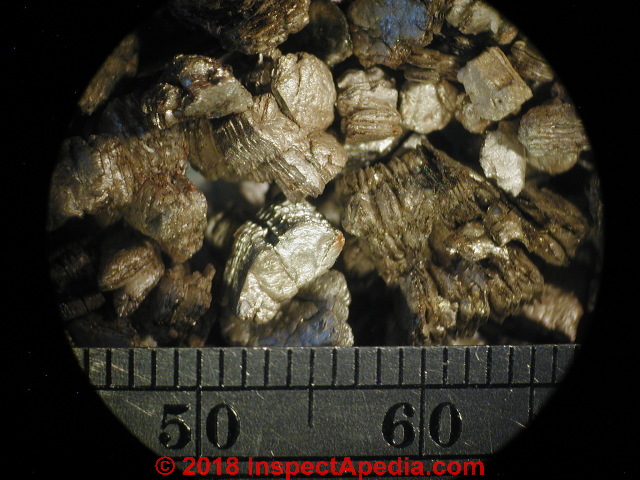 Interestingly the Siscoe vermiculite mine was a subsidiary of the Siscoe gold mine of which more was written.
Interestingly the Siscoe vermiculite mine was a subsidiary of the Siscoe gold mine of which more was written.
Sources I found cite vermiculite mines in southeast Ontario and in Quebec and possibly in the Gowganda Ontario area where cobalt was of principal mining interest.
Some sources report asbestos in the Gowganda area so unless your tests find no asbestos in your vermiculite I would treat it as PACM - presumed asbestos containing material.
In 1959 Siscoe, principally interested in gold mining, sold its two wholly-owned vermiculite interests to a building supplier, Sidney Roofing & Paper Company Ltd. [7].
Photo: Munn & Steele vermiculite under the stereo microscope in our lab.
Since the most-asbestos-contaminated vermiculite in the U.S. came from the Libby Montana mine, that would have been a different source. Much (but probably not all) of the Libby Montana vermiculite was sold under the brand Zonolite.
If you can send me some sharp photos of your vermiculite and of any packaging or markings that would be very helpful.
With all that interesting and useless detail I have to add that even though your vermiculite may contain asbestos we just don't know unless you have a test performed. If you want to do that (please keep me informed) the cost is typically around $50. US. and you can find a lab
...
Munn & Steele "Zonolite" Vermiculite Asbestos Test Results & Photos
Photos above (under the stereo microscope in our lab) and below (EMSL using TEM): Libby Amphibole asbestos fiber detected in our sample of Munn & Steele Zonolite™ Vermiculite insulation during tests conducted in January 2020.
In 2019 we asked a prominent national US testing laboratory, EMSL, to test a sample of Vermiculite that we knew, from its package labeling, was Zonolite™ Vermiculite.
- The test result for our sample No. 007 found less than 4 Libby Amphibole fibers in the sample.
Watch out: Keep in mind these limits of forensic microscopy. By the time a microscopic sample has been prepared for analysis a very small amount of the original bulk sample has been selected. The actual physical volume of material being sampled is extremely small.
When the bulk sample is coarse and not homogeneous, it is likely that different samples may produce varying results in the detection of asbestos.
It is entirely possible that other microscopic samples of the same bulk sample of vermiculite would find different, and perhaps higher levels of asbestos. Details are below.
- ASBESTOS TEST REPORT, VERMICULITE, ZONOLITE [PDF] 2020/01/23 (TEM Qualitative Filtration) Lab report summary.
For our sample no. 042000629-0007
Test result: Libby Amphibole < 4 fibers observed - ASBESTOS TEST DETAILS, VERMICULITE, ZONOLITE [PDF] 2020/01/23 The sample was sent for analysis via TEM Qualitative Filtration
For our sample no. 042000629-0007
Results (TEM) The samples were analyzed with a transmission electron microscope (TEM) at approximately 20,000 X magnification. Asbestos structures are identified by a combination of morphology, quantitative elemental chemistry via Energy Dispersive X- Ray Analysis (EDXA), and Selected Area Electron Diffraction (SAED).
042000629-0007 During TEM examination asbestos was detected on the sample. - Contact: EMSL Analytical, Inc., 200 Route 130 North, Cinnaminson, NJ 08077 USA, Tel: 856-303-2500 - Fax: 856-786-5974 - Toll Free: 800-220-3675
Lab Hours: Mon-Friday 7AM-10PM, Saturday 8AM-5PM, Sunday On-Call.
Some of the resources EMSL Analytical, Inc. offers to our clients:
LABConnect https://extranet.emsl.com/
Order Products http://www.emsl.com/ProductCatalogHome.aspx
Client Corner http://emsl.com/Page.aspx?ID=420
Training http://emsl.com/Training.aspx
Additional Resources http://emsl.com/Links.aspx
Sampling Videos http://www.emsl.tv/
...
What to Do About Your Munn & Steele Vermiculite Insulation
The best way to minimize your risk of amphibole asbestos exposure is to avoid disturbing vermiculite-based insulation in any way.
If vermiculite-based insulation is contained and not exposed to the home or interior environment, it poses very little risk. - Health Canada
See details at
WHAT TO DO ABOUT VERMICULITE INSULATION
Our photos shown above and below illustrate Munn & Steele vermiculite according to our New York reader.
The next vermiculite pictures shown here illustrate the reflective property of mica flakes that will remain even after most of the vermiculite has been expanded into its classic "concertina" form.
...
Packaging of Munn & Steele vs Mica Fil Vermiculite from the Siscoe Mine in Ontario
Photos shown below (provided by InspectApedia.com readers James Patterson and Michael Gou) illustrate packaging and labeling information for two versions of MicaFil vermiculite insulation.
I found a bag in the attic space of my 1952 built home.
Bag is Vermiculite Micafil and indicates manufactured by Sicoe Vermiculite Mines ltd in Cornwall Ontario under franchise from Munn and Steele Inc of Boston Mass.
Probably going to have it tested but wondered if this is possible safer given the source location? - (Feb 9, 2018) James Patterson
Our Reply
James: I have found a 1957 report naming a Steele mine and am researching that
- BIBLIOGRAPHY of NORTH AMERICAN GEOLOGY, 1957, Geological Surveyt Bulletin 1095 [PDF] - this survey includes these two citations:
Gourley, A. Carlisle. A geological and petrological study of Heath Steele Mines, Northumberland county, New Brunswick [abs.]: Canadian 'Min. Jour., v. 78, no. 12, p. 86, Dec. 1957.
Heath Steele mines, Bathurst area, porphyritic arkose: Gourley, A. C.
and some (not much) history of Munn is at vredenburgh.org/mining_history/pdf/AMJ-1941-pt2.pdf that cites the Summar Dredging Copany testing for gold in California in the 1880's. "The ground being tested is owned by Thomas Munn of Willow Springs."
Micafil vermiculite insulation was distributed and sold in both Canada and the U.S., though the packaging of the vermiculite varied.
Our first photo above illustrates Munn and Steele's Mica Fil vermiculite sold out of Boston and providing three different corporate names:
- Bishop Asphalt Papers Ltd., Portneuf Station Quywged PO Toronto, London Ontario, a distributor of MicaFil
- Siscoe Vermiculite Mines Ltd., Cornwall Ontario, the mine site for this Vermiculite
- Munn and Steele Inc., South Boston Massachusetts, licensing the sale of the product in the U.S.
Our second illustration (below) of MicaFil vermiculite insulation in original packaging, was provided courtesy of Michael Gou who posted this photo originally in a Q&A on this page.
I insulated part of a wall with vermiculite in the 1980s. I have found a complete bag for which I enclose photos. Can you tell me if this particular brand was asbestos free or not. Thank you. (Aug 9, 2018) Michel Gou
Our Reply: Asbestos found in some vermiculite mined in Canada
From the packaging showing that Isolation Micafil Vermiculite Insulation was distributed from Montreal, London or Toronto, so I suspect that you are located in Canada.
There was asbestos in some vermiculite mined in Canada.
Please see details about this insulation (where I'll also add your photo) above on this page where I will include your photo and a request for comment from other readers.
I would treat the insulation as presumed to contain asbestos unless or until you have a sample tested.
Reader follow-up:
From historical documents and I did see a Trademark infringement blurb in my search. I was as equally stumped in finding where their product could have been mined.
I did locate another reference to a mas-Celo operation that was suspended in the late 30's and came back on line in the early 40's.
From looking at pictures on line we have a lot of black colored substances that more mirror the micafil than the zonolite.
I was not able to locate any records denoting an affiliation with the WR Grace Libby mine or if the Grace zonolite mined and sent to the Hamilton refinery was ever sold to Munn for redistribution.
Maybe I dodged a big one. My architect said it is not vermiculite but he took a sample to have it tested. I will keep you posted and we have ceased all work.
Reply:
Your architect is almost certainly mistaken - your photos show what is rather unmistakable vermiculite loose fill insulation.
But "vermiculite" does not necessarily mean "asbestos" as we've been discussing. Only a lab test can determine that question.
...
Asbestos in Canadian MicaFil Vermiculite Insulation from Vermiculite Insulation Ltd., Montreal, London, Toronto, Canada?
Hello, we have an attic full of vermiculite Micafil Insulation. It is made in Canada. Our home was built in 1960 in New Brunswick, Canada. - On 2023-12-10 by Shelby
We are planning to get it tested, but do you have any insight into whether or not this would contain asbestos?
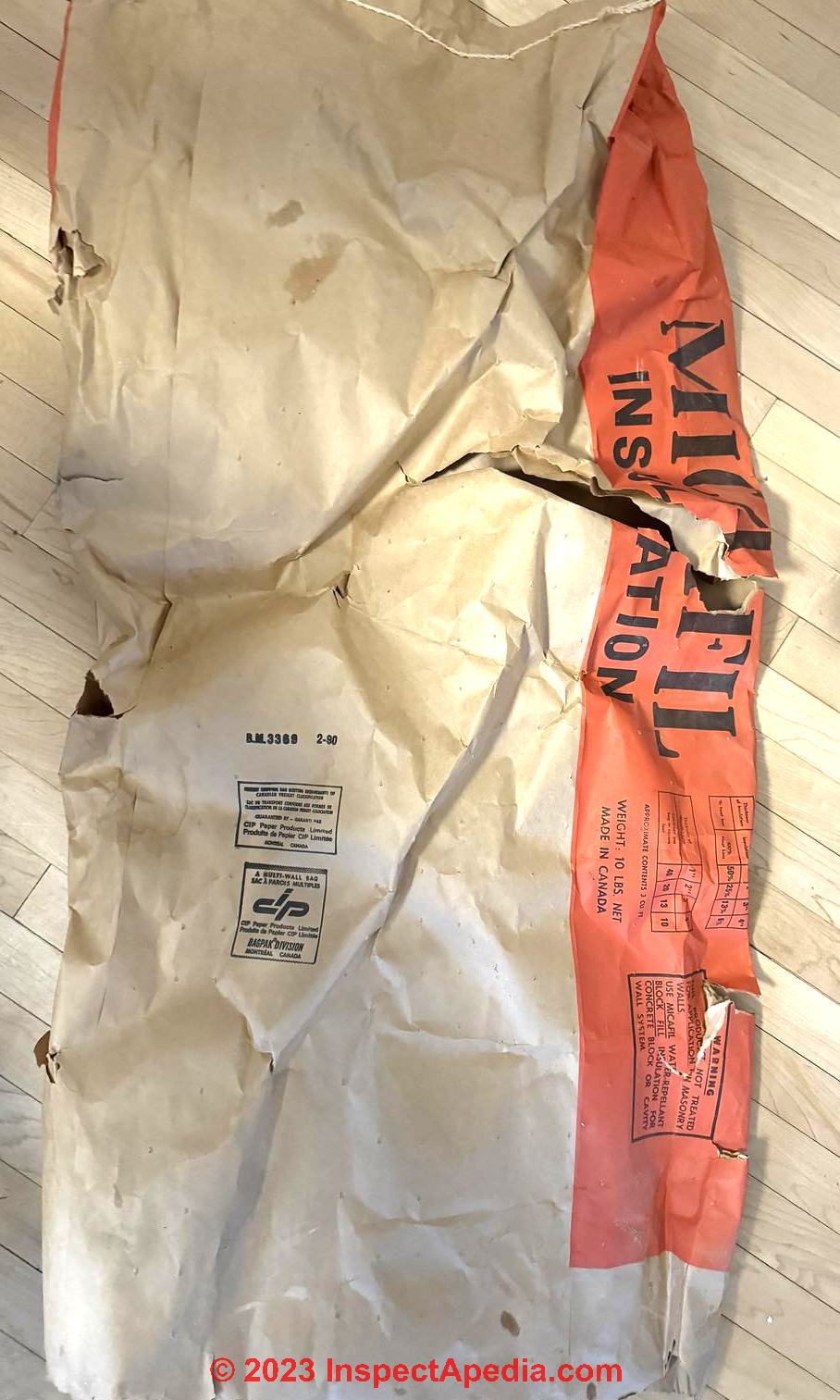
On 2023-12-10 by InspectApedia Publisher - 1960 New Brunswick, Canada home with MicaFil vermiculite insulation
@Shelby,
Thank you for the helpful Mica-Fil vermiculite photos and question.
I looked at your photos to see if there was mention of which mine was the source of that particular vermiculite - without seeing that detail. When we don't know which mine was the source, without sophisticated testing we can't know for sure just what vermiculite mine sources were used when by various vermiculite insulation marketing companies as the principals are too-long gone to ask.
Above on this page I reported (I've edited that a bit here) that
My search for records indicating whether or not Munn & Steele / Mica-Fil actually sold vermiculite that came from the Libby mine (or from the Siscoe mine)
did not find any indicators suggesting a yes or no answer
but it seems certainly possible, since some of the MicaFil packaging that we've seen specifically names the Siscoe vermiculite mine.
So I'd avoid tracking the dust from your insulation into the occupied space, and please do let us know your test result - that will be very helpful to others.
Finally, if you can post sharp photos of any other printing on the MicaFil bag that we can't quite see here that would be helpful as well.
Canadian Westroc & Gold Nugget Vermiculite Insulation - related to MicaFil?
Westroc vermiculite could have originated at more than one location. However, research I cite below cites the Westroc mine in British Columbia (Canada). For that reason Westroc or Westrock and "gold nugget" vermiculite might indeed contain asbestos and may have been a Canadian product.
- Simandl, G.J., Irvine, M.L, Grieve, D., Lane R., Wojdak, P., Madu, B., Northcote, B. and Schroeter, T, "Review of Industrial Minerals in British Columbia, Canada - 2006", retrieved 2016/03/22, original source: www.empr.gov.bc.ca/mining/geoscience/publicationscatalogue/geofiles/documents/gf2007-08.pdf
- George J. Simandl and Angela M. Rossley - B. C. Geological Survey, Industrial Minerals: Current Trends and Future Opportunities, (2000) www.empr.gov.bc.ca/Mining/Geoscience/PublicationsCatalogue/InformationCirculars/Documents/IC2002-03_32-Simandl_Industrial_Minerals.pdf
The term "gold nugget" appears so widely in literature describing some forms of vermiculite that we are reluctant to ascribe that name to a specific mine or vermiculite brand without seeing actual packaging or other documentation.
The U.S. CDC describes "vermiculite" as "Expanded vermiculite is shaped like a small nugget and varies in color from silver-gold to gray-brown."
I have not yet found the specific term Gold Nugget Vermiculite as a specific vermiculite product brand name.
...
Isolation Micafil vermiculite insulation from South Africa: no asbestos detected in lab test
Hello, we found Mica-Fil bags and vermiculite in our attic this fall. We had it tested. I have attached pictures, and the lab report. On 2024-01-04 by DR -
I am happy to report that in our case, the lab did not find any asbestos, and determined the vermiculite was consistent with analysis and visual appearance from a mine in South Africa, which is not known to contain naturally occurring asbestos.
Below is an image of our South African MicaFil vermiculite.
Reply by InspectApedia DF (mod) - Some Mica-Fil tests find no asbestos!
@DR,
Thank you for the packaging photos and for telling us the details of what the test showed.
Thank you so much for taking time to post that result here - it will certainly help other readers.
Indeed lots of vermiculite does not contain asbestos or doesn't contain more than very slight traces of asbestos.
The asbestos hazard depends on where the vermiculite was mined. The Libby vermiculite mine was a principal source of asbestos-contaminated vermiculite.
Knowing the building age and location and thus having a guess at the Mica-Fil vermiculite age and source is also helpful.
Readers can now see this test result and in the related research we cite below
- MICAFIL VERMICULITE INSULATION ASBESTOS TEST LAB RESULTS for DR's sample of Mica-Fil Vermiculite Insulation in a Canadian home thanks to reader DR who sent it to us by private email.
- Hessel, Patrick A., and Gerhard K. Sluis‐Cremer. "X‐ray findings, lung function, and respiratory symptoms in black South African vermiculite workers." American journal of industrial medicine 15, no. 1 (1989): 21-29.
Abstract:
Health effects have been documented among American vermiculite workers who mined and processed vermiculite contaminated with amphibole asbestos, viz., tremolite-actinolite.
Workers mining and processing South African vermiculite (N = 172), which contains very little asbestos, underwent x-ray examination and lung function testing and completed a respiratory symptom questionnaire. The vermiculite workers were compared with other workers involved in the mining or refining of copper.
Only two of the vermiculite workers showed evidence of small opacities of 1/0 or more (according to the ILO 1980 classification); lung function was comparable with the other groups of workers, and there was no excess of respiratory symptoms among the vermiculite workers.
It is concluded that workers exposed to vermiculite that is minimally contaminated with asbestos are probably not at risk for pneumoconiosis, lung function impairment, or respiratory symptoms. It is likely that the health effects observed in other studies of vermiculite workers are the result of concomitant asbestos exposure.
A risk of mesothelioma caused by the fiber content of the vermiculite cannot be excluded by this study. - Moatamed F, Lockey JE, Parry WT. Fiber contamination of vermiculites: a potential occupational and environmental health hazard. Environ Res. 1986 Oct;41(1):207-18. doi: 10.1016/s0013-9351(86)80183-9. PMID: 3019658.
Notes on the South Afrian Palabora Vermiculite Mine
Additional details on South African Vermiculite from InspectApedia reader D.R. including the asbestos test results below:
- D.R. ASBESTOS TEST LAB RESULTS for a SAMPLE of Mica-Fill VERMICULITE [PDF] InspectApedia reader D.R., Pinchin Labs, Canada, 2024/01/04
Watch out: while this report did not find asbestos in this MicaFil vermiculite sample you should note that MicaFil vermiculite sold in Canada may have been mined from various different sources.
Reader D.R. adds: Thank you for converting the lab report to a jpg, and posting it.
I wanted to share it, because there seemed to be so little information on the Mica-fil brand, and location of their mineral sources.
InspectApedia.com was one of the only places I could find anything at all about Mica-Fil and Vermiculite after we were advised by the guy who was going to upgrade our insulation that we had vermiculite under the fibreglass insulation.
Oddly enough, the lack of information on the Mica-fil, in of itself, was reassuring. If it was like the Zonolite vermiculite with asbestos, there would be a lot more information on it (at least, that is what I told myself). I was happy to see the lab results validated my optimism.
It is very interesting that the lab thought the source likely is South Africa. I thought there must be some sort of slight chemical or inclusion difference that allows them to differentiate between areas.
So, I looked to see what I could find. There is a 2001 paper on the www.epa.gov/nscep website, called
- Frank, David, and Lorraine Edmond. FEASIBILITY FOR IDENTIFYING MINERALOGICAL AND GEOCHEMICAL TRACERS FOR VERMICULITE ORE DEPOSITS [PDF] US Environmental Protection Agency, Region 10, 2001. - retrieved 2024/01/05, original source: nepis.epa.gov/
Frank and Edmond note:
“The Palabora deposit has many features in common with the Libby deposit…. One significant difference … is the primary mica at Palabora is phlogopite [the magnesium mica that is yellow, greenish or reddish brown] rather than biotite [the black mica], and the mixed-layer mica/vermiculite alteration product that forms the vermiculite ore is hydrophlogopite [alternation of phlogopite and vermiculite layers] rather than hydrobiotite [a regular alternation of biotite and vermiculite layers]."
And
“…examined the vermiculite ore from Palabora for chrysotile asbestos fibers. They suggest that chrysotile-like fibers (about 2 ppm) in South African ore are instead rolled up scrolls of vermiculite...becoming tubular in appearance, and forming bundles similar [in appearance] to chrysolite.”
NOTE that this article refers to Zonolinte vermiculite, not Munn & Steele MicaFil.
Special thank-you to reader D.R. for finding this research book on identifying the source mines for vermiculite. (2024-01-04)
[Click to enlarge any image]
...
MICAFIL Vermiculite Insulation, MicaFil Division of California Stucco Products
I found this in my attic, home is built in 1959 outside Boston, MA. Not sure when it was poured. Anyone know any details on where it was mined and if it may have asbestos? On 2023-07-08 by milan
Reply by InspectApedia DF (mod) - Not all vermiculite sources contain asbestos
@milan,
You're on the right page for our discussion on Mica Fil vermiculite insulation. Your vermiculite insulation is labeled as provided by the MicaFil Division of California Stucco Products of N.E. Inc., 169 Waverly St., Cambridge 39, Mass, USA.
Can you post a photo of the back of this packaging as well? It would be helpful to see what added information, if any, is included there.
Interestingly on their website, in discussing their history, California Stucco Products makes no mention of producing or selling MicaFil vermiculite insulation in the past.Obviously, your packaging shows that they did at one time. Perhaps not surprising, given the concerns over potentially asbestos-containing products (this is NOT to say that their products contained asbestos), that they don’t choose to advertise this piece of their past.
Not all vermiculite sources contain asbestos. One cannot determine asbestos content in vermiculite by normal visual inspection.
I would treat the insulation as presumed to contain asbestos unless you have a sample tested and find out differently.
Thank you for the photo.Our research to date indicates that California Stucco Products, also listed as CASPRO, used vermiculite mined in South Africa.
MicaFil Vermiculite from CASPRO, California Products Corporation = South African Vermiculite
An InspectApedia reader asked
Do you have any information on MicaFil from California Products Corp?
We found this bag in an attic, the rafters. We are testing the vermiculite based on the premise from the image I include that this vermiculite was mined in South Africa.
I was wondering if you had any information.
My search, shown below, shows that Caspro Vermiculite was "manufactured" by California Stucco Products of N.E., Inc., 169 Waverly Street, Cambridgte Mass.
Moderator reply:
Our search confirmed the Caspro company's description of their vermiculite, used in a variety of applications including a fire-resistant plaster coating for building as well as for building insulation.
From your photo above, you can guess that vermiculite is from South Africa by its lighter color and weight than vermiculite from other mines.
Caspro Vermiculite is mined in South Africa and imported by American Vermiculite Corporation, 654 Madison Avenue, New York, New York. The business products are concrete, plaster and insulation. Text on the front cover margins reads, "A.I.A. File-3-D-3."
...
MicaFil Vermiculite Insulation Research & Information Sources
Shown above is another photo of MicaFil vermiculite insulation packaging from an anonymous reader. In this home additional insulation, most-likely mineral wool, is shown scattered about with some vermiculite particles visible atop and mixed-in with the mineral wool, probably by the installers.
If any readers have asbestos test lab results for this specific product please post those results at the bottom of this page.
- Addison J. Vermiculite: a review of the mineralogy and health effects of vermiculite exploitation. Regul Toxicol Pharmacol. 1995 Jun;21(3):397-405. doi: 10.1006/rtph.1995.1054. PMID: 7480893.
Abstract:
Vermiculite is a mica-type mineral that is being used in increasing quantities for insulation, in composite cements, and in horticulture.
No serious health risks have been found resulting from the exposure to vermiculite alone nor are any anticipated in view of its long-term chemical durability, even with respect to fibers of vermiculite.
Vermiculite ores may contain a variety of other minerals including asbestos, which, if present in significant quantities, could pose a health risk to producers and end users.
A variety of regulations are in place that should prevent inadvertent exposure to asbestos in vermiculites, but great care is needed if true asbestos hazards are to be correctly identified.
At the same time, vermiculites containing any of a variety amphibole minerals should not be excluded from use because of mistaken identification of these minerals as asbestos.
A variety of test methods that have been developed are described and recommendations are made with respect to appropriate action levels for asbestos in vermiculites or other raw materials. - Amandus HE, Wheeler R, Jankovic J, Tucker J. The morbidity and mortality of vermiculite miners and millers exposed to tremolite-actinolite: Part I. Exposure estimates. Am J Ind Med. 1987;11(1):1-14. doi: 10.1002/ajim.4700110102. PMID: 3028135.
Abstract:
The vermiculite ore and concentrate of a mine and mill near Libby, Montana, was found to be contaminated with fibrous tremolite-actinolite.
Of 599 fibers (length greater than 5 microns and width greater than 0.45 micron) counted in eight airborne membrane filter samples, 96% had an aspect ratio greater than 10 and 16% had an aspect ratio greater than 50.
Additionally, 73% of the fibers were longer than 10 microns, 36% were longer than 20 microns, and 10% were longer than 40 microns.
Estimates of exposure before 1964 in the dry mill were 168 fibers/cc for working areas, 182 fibers/cc for sweepers, 88 fibers/cc for skipping, and 13 fibers/cc for the quality control laboratory.
In 1964-1971, exposure estimates for these areas were 33, 36, 17, and 3 fibers/cc, respectively. Estimates of exposures in the mine before 1971 ranged from 9-23 fibers/cc for drillers and were less than 2 fibers/cc for nondrilling jobs.
All 8-hr TWA job exposure estimates decreased from 1972-1976, and from 1977-1982 were less than 1 fiber/cc. - ATSDR, VERMICULITE CONSUMER PRODUCTS [PDF] U.S. CDC, Centers for Disease Control, retrieved 2018/08/09, original source: https://www.atsdr.cdc.gov/NEWS/vermiculite051603.pdf
- Canada, NWT, MANAGEMENT OF ASBESTOS IN ZONOLITE® - VERMICULITE INSULATION [PDF] Canadian Northwest Territories, Public Works & Services, PWS Asbestos Coordinator
Technical Support Services
Asset Management Division, Public Works and Services
S.M. Hodgson Building, 3rd Floor
Box 1320, Yellowknife, NT X1A 2L9
Tel: (867) 920-8835 or (867) 920-8088
Fax: (867) 873-0226 - retrieved 2023/12/27 original source: inf.gov.nt.ca/sites/inf/files/management_of_vermiculite_brochure.pdf
- D.R. ASBESTOS TEST LAB RESULTS for a SAMPLE of Mica-Fill VERMICULITE [PDF] InspectApedia reader D.R., Pinchin Labs, Canada, 2024/01/04
Watch out: while this report did not find asbestos in this MicaFil vermiculite sample you should note that MicaFil vermiculite sold in Canada may have been mined from various different sources.
- Frank, David, and Lorraine Edmond. FEASIBILITY FOR IDENTIFYING MINERALOGICAL AND GEOCHEMICAL TRACERS FOR VERMICULITE ORE DEPOSITS [PDF] US Environmental Protection Agency, Region 10, 2001. - retrieved 2024/01/05, original source: nepis.epa.gov/
- Health Canada, VERMICULITE INSULATION CONTAINING, AMPHIBOLE ASBESTOS [PDF], Health Canada, September 2009, web search Jan 2011, source hc-sc.gc.ca/hl-vs/iyh-vsv/prod/insulation-isolant-eng.php
Quoting
Some vermiculite insulation may contain amphibole asbestos fibres. These products can cause health risks if disturbed during maintenance, renovation or demolition.
However, there is currently no evidence of risk to your health if the insulation is sealed behind wallboards and floorboards, isolated in an attic, or otherwise kept from exposure to the interior environment. - [1] Intellectual Property Law of Canada - Second Edition, Stuart C. McCormack
- [2] Offners International Trademark Service, Vol. 6, Eric D Offner, 1970.
- [3] 48 Trademark Rep. 917 (1958) Recent Canadian Decisions; Fox, Harold G.
- Hessel, Patrick A., and Gerhard K. Sluis‐Cremer. "X‐ray findings, lung function, and respiratory symptoms in black South African vermiculite workers." American journal of industrial medicine 15, no. 1 (1989): 21-29.
- Moatamed F, Lockey JE, Parry WT. Fiber contamination of vermiculites: a potential occupational and environmental health hazard. Environ Res. 1986 Oct;41(1):207-18. doi: 10.1016/s0013-9351(86)80183-9. PMID: 3019658.
Abstract:
Vermiculite ores from Montana, Virginia, and South Africa have been analyzed for the presence of amphibole contamination.
Fibrous actinolite was found in unexpanded Montana vermiculite ore at a maximum concentration of 2.0%.
The fibers persisted in the expanded ore at a maximum concentration of 0.6%.
Actinolite was also found in the Virginia vermiculite ore but at a lower concentration and mostly as cleavage fragments with low length-to-width ratios.
South African ore contained rare anthophyllite fibers also with low length-to-width ratios.
Vermiculite ores have the potential for amphibole contamination and can represent potential health hazards without proper occupational and environmental control measures. - Gamble JF, Gibbs GW. An evaluation of the risks of lung cancer and mesothelioma from exposure to amphibole cleavage fragments. Regul Toxicol Pharmacol. 2008 Oct;52(1 Suppl):S154-86. doi: 10.1016/j.yrtph.2007.09.020. Epub 2007 Oct 22. PMID: 18396365.
Abstract:
Amphiboles are hydrated mineral silicates five of which occur in asbestiform habits as asbestos grunerite (amosite) asbestos, riebeckite (crocidolite) asbestos, anthophyllite asbestos, tremolite asbestos and actinolite asbestos] and non-asbestiform habits (grunerite, riebeckite, anthophyllite, tremolite and actinolite).
The asbestiform varieties are characterized by long, thin fibers while non-asbestiform varieties such as cleavage fragments form short fibers with larger widths. The U.S. regulatory method for counting asbestos fibers (aspect ratio > or = 3:1, length > or = 5 microm) does not distinguish between asbestos and cleavage fragments.
The method biases toward increased counts of non-asbestiform cleavage fragments compared to long, thin asbestos fibers.
One consequence of this regulatory approach is that workers can be erroneously classified as exposed to concentrations of asbestos (asbestiform amphiboles) above the U.S. 0.1 f/mL exposure standard when in fact they are not exposed to asbestos at all but non-asbestiform amphibole cleavage fragments.
Another consequence is that the known carcinogenic effects of asbestos may be falsely attributed to non-asbestiform amphibole cleavage fragments of the same mineral.
The purpose of this review is to assess whether amphibole cleavage fragments pose the same risk of lung cancer and mesothelioma characteristic of amphibole asbestos fibers.
We identified three groups of workers exposed to non-asbestiform amphiboles: two groups exposed to grunerite (Homestake gold miners and taconite miners) and one group exposed to industrial talc containing non-asbestiform tremolite and anthophyllite in St. Lawrence County, NY.
In addition to assessing strength of association and exposure-response trends in the non-asbestiform amphibole cohorts, comparisons were also made with cohorts exposed to the asbestiform counterpart (positive control) and cohorts exposed to the mineral (e.g. talc) that does not contain amphiboles (negative controls).
The cohorts exposed to non-asbestiform amphiboles had no excesses of lung cancer or mesothelioma. Similar results were observed in the negative control groups, in stark contrast to the excess risks of asbestos-related disease found in the asbestos cohorts.
The only possible exception is the twofold increased risk of lung cancer where exposure was to industrial talc containing cleavage fragments of tremolite and anthophyllite.
However, this risk is not considered attributable to the talc or amphibole cleavage fragments for several reasons. A similar increased risk of lung cancer was found in Vermont talc workers, studied in the same time period.
Their exposure was to relatively pure talc. There was no relationship between lung cancer mortality and exposure measured as mg/m(3)years and years worked. A case-control study reported that all the lung cancer cases were smokers (or former smokers) and attributed the excess to smoking.
There were two mesothelioma cases among the NY State talc workers exposed to cleavage fragments of tremolite and anthophyllite, but talc is not a plausible cause because of too short latency and potential for previous asbestos exposure.
The positive controls of tremolite asbestos and anthophyllite asbestos exposed workers showed excess risks of both lung cancer and mesothelioma and positive exposure-response trends. St. Lawrence, NY talc does not produce mesotheliomas in animals while amphibole asbestos does.
In sum, the weight of evidence fully supports a conclusion that non-asbestiform amphiboles do not increase the risk of lung cancer or mesothelioma. - [5] Guillet, G.R., "Vermiculite in Ontario, With an Appendix on Perlite", Ontario Department of Mines, 1962, http://www.geologyontario.mndmf.gov.on.ca/mndmfiles/
pub/data/imaging/IMR007/IMR007.pdf - McDonald JC, McDonald AD, Sébastien P, Moy K. Health of vermiculite miners exposed to trace amounts of fibrous tremolite. Br J Ind Med. 1988 Sep;45(9):630-4. doi: 10.1136/oem.45.9.630. PMID: 2846033; PMCID: PMC1009667.
Abstract:
A small cohort of 194 men with low exposure to fibrous tremolite (mean 0.75 f/ml y) in the mining and milling of vermiculite in South Carolina experienced 51 deaths 15 years or more from first employment.
The SMR (all causes) was 1.17 reflecting excess deaths from circulatory disease. There were four deaths from lung cancer and 3.31 expected (SMR 1.21, 95% CI 0.33-3.09). Three of the four deaths were in the lowest exposure category (less than 1 f/ml y); no death was attributed to mesothelioma or pneumoconiosis.
These findings contrast with those in Montana where the vermiculite ore was heavily contaminated with fibrous tremolite.
A radiographic survey of 86 current and recent South Carolina employees found four with small parenchymal opacities (greater than or equal to 1/0) and seven with pleural thickening.
These proportions were not higher than in a non-exposed group and much lower than had been observed in Montana. Examination of sputum from 76 current employees showed that only two specimens contained typical ferruginous bodies, confirming low cumulative fibre exposure.
Any possible adverse effects of work with vermiculite, minimally contaminated with fibrous or non-fibrous tremolite, were thus beyond the limits of detection in this workforce.
- MICAFIL VERMICULITE INSULATION ASBESTOS TEST LAB RESULTS for DR's sample of Mica-Fil Vermiculite Insulation in a Canadian home [PDF] thanks to reader DR who sent it to us by private email.
- Price B. Exposure to airborne amphibole structures and health risks: Libby, Montana. Regul Toxicol Pharmacol. 2008 Oct;52(1 Suppl):S97-S109. doi: 10.1016/j.yrtph.2007.09.015. Epub 2007 Oct 10. PMID: 18006127.
Abstract:
Libby, Montana is the site of a large vermiculite deposit that was mined between 1920 and 1990 to extract vermiculite for commercial applications such as insulation, gardening products, and construction materials.
The Libby vermiculite deposit also contains amphibole minerals including tremolite, actinolite, richterite, and winchite.
Historically, Libby mine workers experienced high exposures to amphibole structures, and, as a group, have experienced the health consequences of those occupational exposures.
It has been suggested that Libby residents also have been and continue to be exposed to amphibole structures released during the vermiculite mining operations and therefore are at increased risk for disease.
The Agency for Toxic Substance and Disease Registry (ATSDR) conducted two epidemiological-type studies of residents living in Libby and the surrounding areas to assess these risks.
The Environmental Protection Agency (EPA) collected and analyzed exposure data in Libby and used those data to project risks of asbestos-associated disease for Libby residents.
The EPA has placed the Libby Asbestos Site, which includes the mine and the town of Libby, on its National Priority List of hazardous waste sites in need of clean up.
This article presents a review of the exposure studies conducted in Libby and an analysis of health risks based on the data collected in those studies.
Libby mine workers have experienced elevated levels of asbestos-associated disease as a consequence of their occupational exposures to amphibole structures.
Libby residents' exposures typically are substantially lower than mine workers' historical exposures, and the health risk projections for residents are, accordingly, substantially lower. - [4] SISCOE VERMICULITE MINES LTD., V.I.L. VERMICULITE INC. 1775 -52nd Avenue Lachine H8T 2Y1 QUÉBEC produced vermiculite insulation from (at least ) 1959
La propriété Siscoe Est est située à 3 km au nord-ouest de Val-d'Or, au Québec, près des anciennes mines Siscoe et Sullivan qui, ensemble, ont produit plus de 2,1 millions d'onces d'or entre les années 1930 et 1968.
C'est aussi le site de l'ancienne mine Stabell qui a produit 1 750 onces d'or provenant de minerai titrant en moyenne 0,27 once d'or par tonne de 1935 à 1937.
La propriété repose sur les roches volcaniques du Groupe de Malartic Inférieur vers le nord-ouest et sur une intrusion de granodiorite régionale connue sous le nom de batholite de Bourlamaque, vers le sud-est.
En 2006, Alexandria a achevé une campagne de forage de 2 750 m et par la suite, Niogold a conclu une entente de coentreprise pour acquérir une participation de 50 % dans la propriété en 2008.
Actuellement, Niogold est l'exploitant principal sur la propriété et a achevé un programme d'exploration à la fin de 2009. - see Alexandria Minerals at http://azx.ca/french/projects/siscoe/summary.html - [6] Siscoe Vermiculite Mines Ltd. v. Munn & Steele Inc. (1957)
- [7] The Montreal Gazette - Mar 26, 1960
- [8] mining journal, http://vredenburgh.org/mining_history/pdf/AMJ-1940-pt1.pdf
- [9] North, Oliver S., & Jensen, Nan C., VERMICULITE [pDF] undated, approx, 1955, document from U. Wisconsin, images.library.wisc.edu/EcoNatRes/EFacs2/MineralsYearBk/MinYB1954v1/
reference/econatres.minyb1954v1.onorth6.pdf - Schundler, VERMICULITE MSDS [PDF] Schundler's vermiculite product Safety Data Sheet
...
...
Continue reading at VERMICULITE INSULATION INCIDENTAL EXPOSURE HAZARDS ? or select a topic from the closely-related articles below, or see the complete ARTICLE INDEX.
Or see MUNN & STEELE VERMICULITE, MICA-FIL FAQs - questions & answers posted originally at this page.
Or see these
Recommended Articles
- ASBESTOS TESTING LAB LIST
- INSULATION IDENTIFICATION GUIDE
- VERMICULITE INSULATION - home
- HOW TO IDENTIFY VERMICULITE INSULATION
- MICA-FIL, MUNN & STEELE, CALIFORNIA, CANADA, & SISCO VERMICULITE ASBESTOS
- WHAT TO DO ABOUT VERMICULITE INSULATION
- VERMICULITE HISTORY & PROPERTIES
- VERMICULITE INSULATION INCIDENTAL EXPOSURE HAZARDS ?
- ZONOLITE BRAND VERMIULITE INSULATION ZAI & CLAIMS
Suggested citation for this web page
MICA-FIL, MUNN & STEELE, CALIFORNIA, CANADA, & SISCO VERMICULITE ASBESTOS at InspectApedia.com - online encyclopedia of building & environmental inspection, testing, diagnosis, repair, & problem prevention advice.
Or see this
INDEX to RELATED ARTICLES: ARTICLE INDEX to ASBESTOS HAZARDS
Or use the SEARCH BOX found below to Ask a Question or Search InspectApedia
Ask a Question or Search InspectApedia
Try the search box just below, or if you prefer, post a question or comment in the Comments box below and we will respond promptly.
Search the InspectApedia website
Note: appearance of your Comment below may be delayed: if your comment contains an image, photograph, web link, or text that looks to the software as if it might be a web link, your posting will appear after it has been approved by a moderator. Apologies for the delay.
Only one image can be added per comment but you can post as many comments, and therefore images, as you like.
You will not receive a notification when a response to your question has been posted.
Please bookmark this page to make it easy for you to check back for our response.
IF above you see "Comment Form is loading comments..." then COMMENT BOX - countable.ca / bawkbox.com IS NOT WORKING.
In any case you are welcome to send an email directly to us at InspectApedia.com at editor@inspectApedia.com
We'll reply to you directly. Please help us help you by noting, in your email, the URL of the InspectApedia page where you wanted to comment.
Citations & References
In addition to any citations in the article above, a full list is available on request.
- ASBESTOS IN YOUR HOME - U.S. EPA, Exposure Evaluation Division, Office of Toxic Substances, Office of Pesticides and Toxic Substances, U.S. Environmental Protection Agency, Washington,D.C. 20460>
- [5] Vermiculite: Protect Your Family from Asbestos-Contaminated Vermiculite Insulation, U.S. EPA, web search 08/17/2010, original source: http://www.epa.gov/asbestos/pubs/verm.html
- [8] Vermiculite: Protect Your Family from Asbestos-Contaminated Vermiculite Insulation, U.S. EPA , web search 08/17/2010, original source: http://www.epa.gov/asbestos/pubs/verm.html [copy on file as hazmat/Vermiculite_US_EPA.pdf/ Current Best Practices for Vermiculite Attic Insulation - May 2003, U.S. EPA
Web search 01/20/2011, original source: http://epa.gov/asbestos/pubs/verm_questions.html - Proteja su familia del aislante de vermiculita contaminado con asbestos, U.S. EPA HOJA INFORMATIVA web search 08/17/2010, original source http://www.epa.gov/asbestos/pubs/verm-ques-sp.pdf
- [10] "Zonolite Attic Insulation Safety Facts", W.R. Grace Corporation, web search 5/1/2012, original source: http://www.grace.com/about/ehs/libby/zonolite.aspx, [copy on file as /2 Environmental Hazards/Asbestos/Zonolite_Grace_Info.pdf ]
- [11] "Libby Timeline", W.R. Grace Corporation, web search 4/28/12, original source :http://www.grace.com/about/ehs/libby/timeline.aspx
[copy on file as [Libby_History_Grace.pdf] - [13] Stanton, .F., et al., National Bureau of Standards Special Publication 506: 143-151
- [14] Pott, F., Staub-Reinhalf Luft 38, 486-490 (1978) cited by McCrone
- [15] "Financial Reorganization", W.R. Grace corporation, web search 5/8/11, original source: http://www.grace.com/About/Reorganization.aspx, [copy filed as /Grace_Financial_Reorg.pdf]
- [16] The Perlite Institute, Inc., 4305 North Sixth Street Suite A Harrisburg, PA 17110, Tel: 717-238-9723, Fax: 717-238-9985, Email: info@perlite.org, Website: http://www.perlite.org/
- [17] Schundler Company, Edison, NJ 732-287-2244 email: info@schundler.com Schundler provides information about the application-use of both perlite and vermiculite insulation products.
- [18] "Coping With Suspect Insulation", Jay Romano, The New York Times, 8 June 2003, p. 7
- [19] "Hazardous Materials: EPA’s Assessment of Sites that May Have Received Asbestos-Contaminated Ore from Libby, Montana (GAO-09-7sp, March 2009), an E-supplement to GAO-09-6R - Koos Inc., 2000 DeKovan Avenue, Racine, Wisconsin", The U.S. Government Accounting Office, Special Publications, web search 5/8/12, original source: http://www.gao.gov/special.pubs/gao-09-7sp/file155.html
- [20] "Hazardous Materials: EPA’s Assessment of Sites that May Have Received Asbestos-Contaminated Ore from Libby, Montana (GAO-09-7sp, March 2009), an E-supplement to GAO-09-6R - Koos Inc., 2000 DeKovan Avenue, Racine, Wisconsin", The U.S. Government Accounting Office, Special Publications, web search 5/8/12, original source: Former exfoliation facility: http://www.gao.gov/special.pubs/gao-09-7sp/file154.html
- Asbestos products and their history and use in various building materials such as asphalt and vinyl flooring includes discussion which draws on ASBESTOS, ITS INDUSTRIAL APPLICATIONS, ROSATO 1959, D.V. Rosato, engineering consultant, Newton, MA, Reinhold Publishing, 1959 Library of Congress Catalog Card No.: 59-12535 (out of print, text and images available at InspectAPedia.com).
- Basic Information about Asbestos, US EPA, web search 08/17/2010, original source: http://www.epa.gov/asbestos/pubs/help.html
- "Handling Asbestos-Containing roofing material - an update", Carl Good, NRCA Associate Executive Director, Professional Roofing, February 1992, p. 38-43
- EPA Guidance for Controlling Asbestos-Containing Materials in buildings, NIAST, National Institute on Abatement Sciences & Technology, [republishing EPA public documents] 1985 ed., Exposure Evaluation Division, Office of Toxic Substances, Office of Pesticides and Toxic Substances, U.S. Environmental Protection Agency, Washington,D.C. 20460
- In addition to citations & references found in this article, see the research citations given at the end of the related articles found at our suggested
CONTINUE READING or RECOMMENDED ARTICLES.
- Carson, Dunlop & Associates Ltd., 120 Carlton Street Suite 407, Toronto ON M5A 4K2. Tel: (416) 964-9415 1-800-268-7070 Email: info@carsondunlop.com. Alan Carson is a past president of ASHI, the American Society of Home Inspectors.
Thanks to Alan Carson and Bob Dunlop, for permission for InspectAPedia to use text excerpts from The HOME REFERENCE BOOK - the Encyclopedia of Homes and to use illustrations from The ILLUSTRATED HOME .
Carson Dunlop Associates provides extensive home inspection education and report writing material. In gratitude we provide links to tsome Carson Dunlop Associates products and services.


